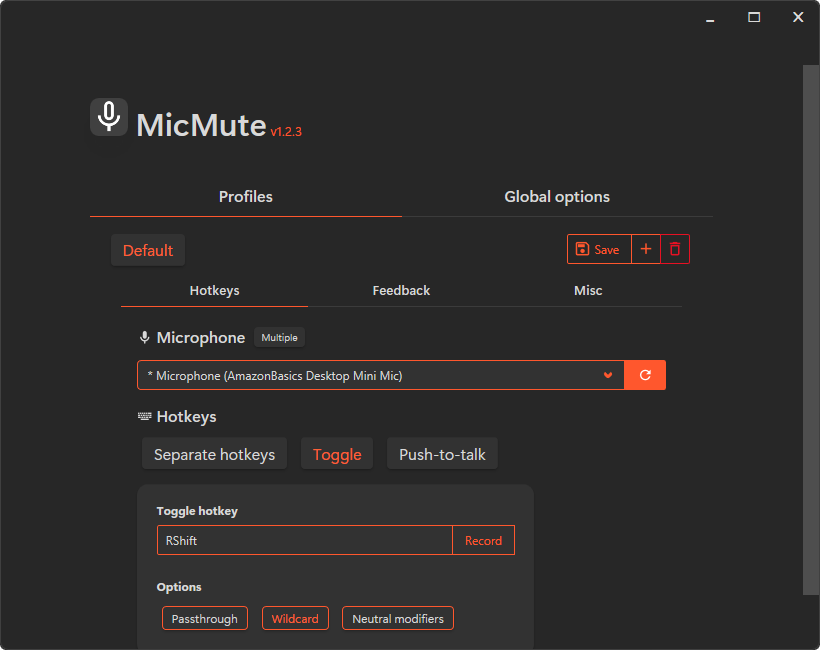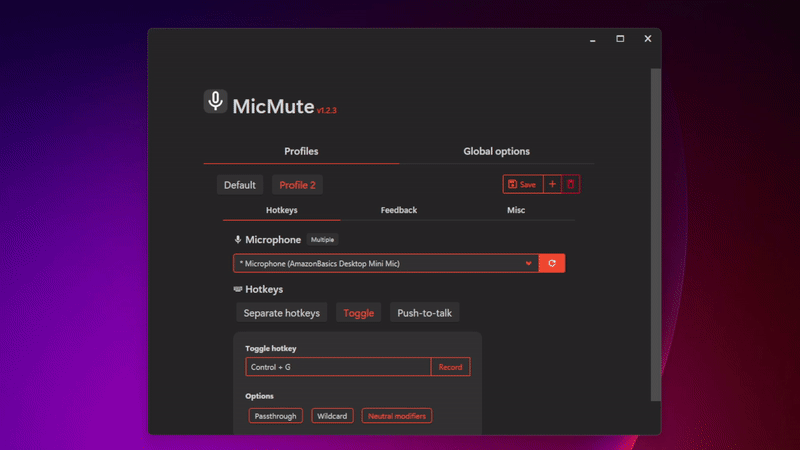Control your microphone using keyboard and mouse hotkeys.
- Set up multiple profiles and link them to apps/games
- Control multiple microphones simultaneously
- Use separate hotkeys for Mute/Unmute or a single toggle/push-to-talk hotkey
- AFK timeout (auto mute when idling for longer than a specific time interval)
- Optional sound and on-screen feedback with ability to use custom sounds
- Always-on-top overlay to show the microphone's state
Note: Starting with v1.1.1, MicMute.exe is 64-bit only.
A. Install using Scoop
# Add the extras bucket
scoop bucket add extras
# Install MicMute
scoop install micmute You can update MicMute using scoop update micmute, your config file will be saved between updates.
You can download MicMute and use it standalone.

The first time you launch MicMute, a configuration window will open
- Select your microphone from the list.
- Choose the hotkey type (Toggle, Push-to-talk or seperate hotkeys).
- Select the hotkey options you want. see hotkey options.
- Click Record and press the key(s) combination for the hotkey, then click on Stop to save it.
- Go to the
Feedbacktab and select the feedback options you want. see feedback options. - If you're setting up multiple profiles, you can link a profile to an app/game. see linked applications.
- If you want the microphone to be auto muted when you idle, setup
AFK timeout. - If you're setting up a PTT hotkey, you can change the delay between releasing the key and the audio cutting off by changing the
PTT delayoption. - Click on the save button.
-
You can change a profile's name by right clicking it.
-
When you set up a hotkey for a microphone, a
*will appear before the microphone's name
| Option | Description |
|---|---|
| Passthrough | If this is turned off, the hotkey will only work for MicMute and will be hidden from the rest of the system. |
| Wildcard | If this is turned off, the hotkey will not work if you press extra modifiers. for example if the hotkey is Ctrl M and you press Ctrl Shift M , the hotkey will not be triggered. |
| Neutral modifiers | If this is turned off, the hotkey can have a specific modifier (Right or Left) instead of a neutral one (example: RCtrl instead of Ctrl, this will only be triggered by the right control key). This option should be set before recording the hotkey. |
Play a sound when muting/unmuting the microphones.
-
You can select which output device to play the sound on.
-
You can use custom sounds:
- Turn on the option in the config UI
- Make sure the sound files (
mp3,wav) are in the same folder asMicMute.exe - Rename them as:
-
Mute sound:
mute -
Unmute sound:
unmute -
PTT on:
ptt_on -
PTT off:
ptt_off
-
Show an OSD when muting/unmuting the microphones.
-
You can change the OSD position (default position is the bottom center of the screen, above the taskbar).
-
You can exclude fullscreen apps/games from the OSD, this is needed for some games that lose focus when the OSD is shown.
Show the microphone's state in an always-on-top overlay.
-
CTRL ALT F9 toggles show/hide
-
CTRL ALT F10 toggles locked/unlocked
-
You can drag the overlay to change its position when it's unlocked
-
Games need to be set to
Windowed fullscreenorBorderlessfor the overlay to show up on top -
You can set the overlay to only show if the microphone is muted or unmuted
-
You can use custom icons for the overlay. To do this, turn on the option in the config UI, then place the icons (
ico/png/jpeg) in the same folder asMicMute.exeand rename them as:- Mute icon:
overlay_mute - Unmute icon:
overlay_unmute
Avoid using icons that have a gray
#232323color - Mute icon:
Link a profile to an app/game, when the app becomes visible (not minimized or hidden), MicMute will automatically switch to that profile, when the app is minimized/hidden/closed, MicMute will switch back to the default profile.
These options are shared between all profiles.
Mute the microphone(s) when starting up or switching profiles.
Show an OSD with the profile's name when switching to it.
UI Theme can be set to System Theme, Dark or Light
This does not affect the tray icon color, which is always based on the system theme
Prevent other apps from changing the microphone's state (i.e mute/unmute the microphone).
Note: This might break the unmute functionality in some apps, if this happens you'll need to unmute the microphone using MicMute before unmuting inside the app)
You can have multiple active hotkeys to control different microphones simultaneously.
To do this, turn on the Multiple option then select another microphone from the list and setup hotkeys for it.
When using this feature, the following applies:
- The tray icon will be the static MicMute icon
- The tray icon will no longer act as a toggle button, and the tray menu option to toggle the microphone will be disabled
- The On-screen feedback OSD will show the microphone name when muting/unmuting
- The On-screen overlay is disabled
Alternatively, you can control all the microphones at once with the same hotkey by selecting All Microphones from the microphones list.
When using this feature, the following applies:
- The
Multipleoption will be disabled - The
Force Microphone Stateoption will be enabled
-
When running AutoHotkey alongside Microsoft Powertoys, they might conflict with each other, which may result in the hotkeys not working at all. microsoft/PowerToys#2132
-
Albion Online detects MicMute as a botting tool, the games blacklists anything written in autohotkey and marks it as a botting tool. #23
-
Windows defender might falsely detect MicMute as a trojen/malware (
Zpevdo.BorWacatac.B!ml). I always submit new releases to microsoft to remove the false detections and they usually do in a couple of days, but sometimes when they release a new definition update the detection occurs again. #25
Hold shift when asked to setup a profile or when clicking "Edit configuration" from the tray menu, and the config file will open in the default JSON editor
//config.json example
{
"AllowUpdateChecker": 0,
"DefaultProfile": "Default",
"MuteOnStartup": 1,
"PreferTheme": -1,
"Profiles": [
{
"afkTimeout": 2,
"ExcludeFullscreen": 0,
"LinkedApp": "",
"Microphone": [
{
"MuteHotkey": "~*RShift",
"Name": "Microphone (AmazonBasics Desktop Mini Mic)",
"PushToTalk": 0,
"UnmuteHotkey": "~*RShift"
}
],
"OnscreenFeedback": 0,
"OnscreenOverlay": 1,
"OSDPos": {
"x": -1,
"y": -1
},
"OverlayOnMuteOnly": 0,
"OverlayPos": {
"x": 2486,
"y": 387
},
"OverlayUseCustomIcons": 0,
"ProfileName": "Default",
"PTTDelay": 50,
"SoundFeedback": 1,
"SoundFeedbackDevice": "Default",
"SoundFeedbackUseCustomSounds": 0,
"UpdateWithSystem": 1
}
],
"SwitchProfileOSD": 1
}| Argument | Description |
|---|---|
/profile=<profile name> |
Startup with a specific profile. |
/noUI |
Disable the configuration UI completely. This decreases memory usage by almost 60%. |
/debug |
Add shortcuts to ListVars, ListHotkeys and View Log in the tray menu. |
/logFile=<file_to_log_to> |
Outputs the log to a file (it's written to stdout by default ) |
Example: MicMute.exe "/profile=profile 1" /noUI /debug /logFile=MicMute.log
Note: Run the following commands in powershell, not command prompt.
You'll need AutoHotkey (Ahk2Exe) and git in your path.
You can install them using scoop:
- Install scoop
# This allows running powershell scripts. Set-ExecutionPolicy RemoteSigned -scope CurrentUser; # This runs the scoop installer script. iwr -useb get.scoop.sh | iex;
- Install prerequisites
scoop install git; scoop bucket add extras; scoop install autohotkey;
git clone --recurse-submodules https://github.com/SaifAqqad/AHK_MicMute.git;
cd .\AHK_MicMute\;If you had already cloned the repository without submodules, Run the following command:
git submodule update --init --recursive;Invoke-WebRequest "www.un4seen.com/files/bass24.zip" -OutFile ".\bass24.zip";
Expand-Archive ".\bass24.zip" -DestinationPath ".\base24\";
Copy-Item ".\base24\x64\bass.dll" -Destination ".\src\Lib\bass.dll";ahk2exe.exe /in ".\src\MicMute.ahk" /out ".\src\MicMute.exe";| Library | License |
|---|---|
| Material Design icons | Apache 2.0 |
| BASS audio library | License |
| VA.ahk | License |
| Bulma CSS framework | MIT |
| G33kDude/cJson.ahk | MIT |
| G33kDude/Neutron.ahk | MIT |
This project would not exist without these people:
- mistificat0r (The original MicMute)
- G33kDude (cJson, Neutron, etc)
- Lexikos (Autohotkey, VA.ahk)
- SKAN (ResRead, VerCmp, etc)
- jNizM
- probably more...





